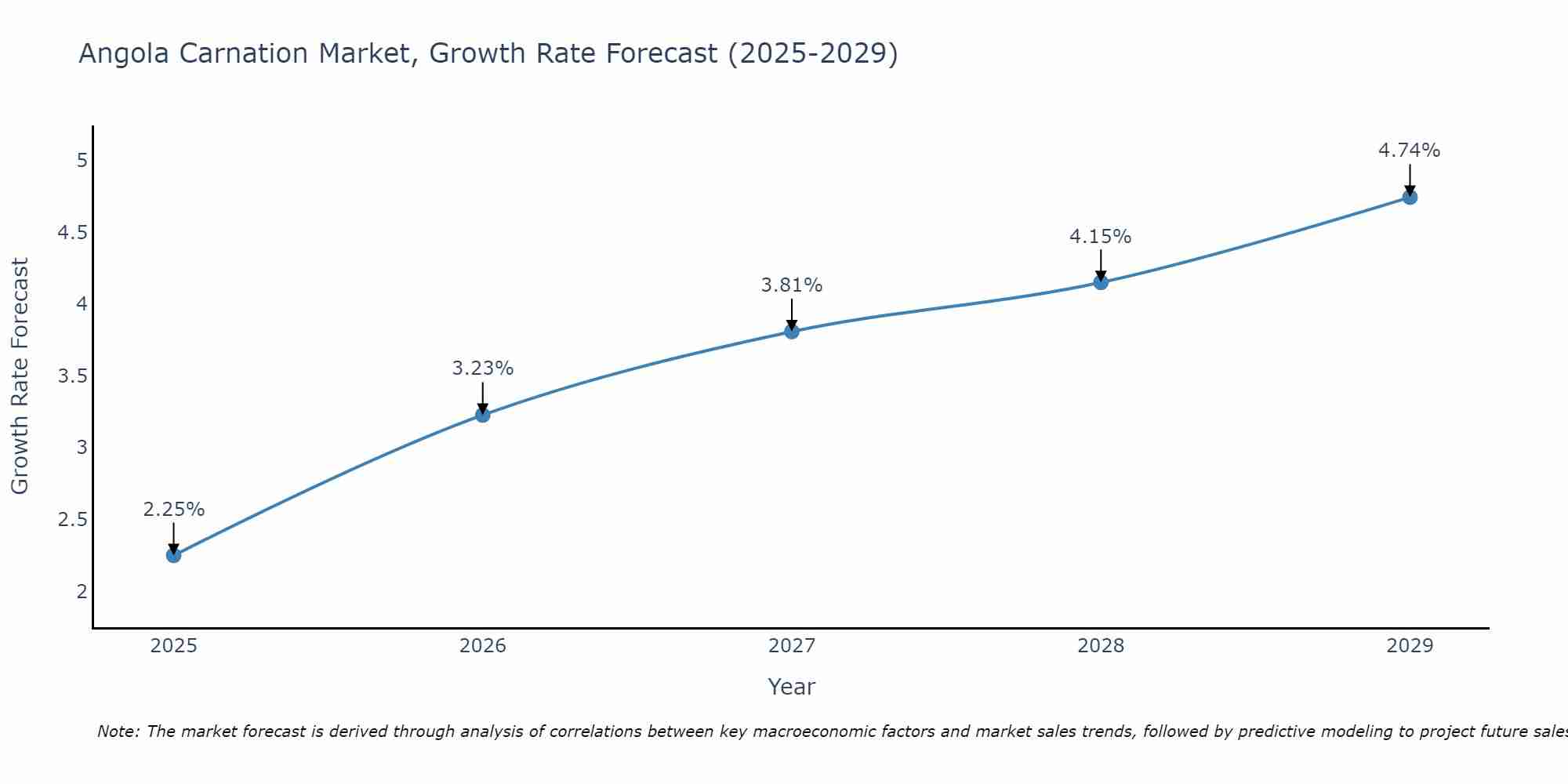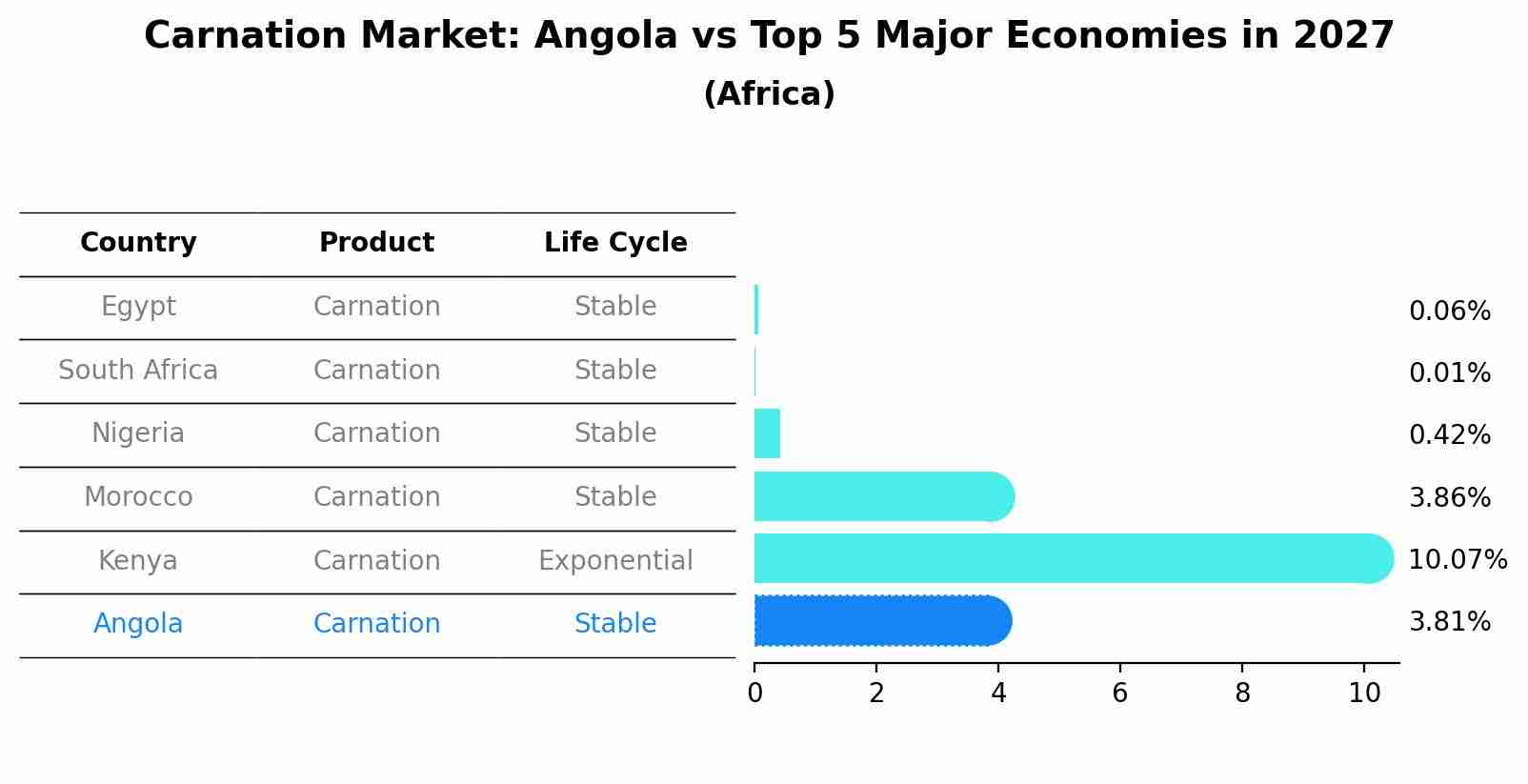Angola Carnation Market (2025-2031) | Value, Share, Forecast, Segmentation, Revenue, Industry, Growth, Size, Trends, Analysis, Companies & Outlook
| Product Code: ETC5341143 | Publication Date: Nov 2023 | Updated Date: Aug 2025 | Product Type: Market Research Report | |
| Publisher: 6Wresearch | Author: Bhawna Singh | No. of Pages: 60 | No. of Figures: 30 | No. of Tables: 5 |
Angola Carnation Market Size Growth Rate
The Angola Carnation Market is likely to experience consistent growth rate gains over the period 2025 to 2029. From 2.25% in 2025, the growth rate steadily ascends to 4.74% in 2029.

Carnation Market: Angola vs Top 5 Major Economies in 2027 (Africa)
By 2027, Angola's Carnation market is forecasted to achieve a stable growth rate of 3.81%, with Egypt leading the Africa region, followed by South Africa, Nigeria, Morocco and Kenya.

Angola Carnation Market Overview
The carnation market in Angola is niche yet promising, driven by local floral culture and growing demand for ornamental plants. Domestic production supports local florists and landscaping businesses, while imports cater to specialized varieties and seasonal demands. Market dynamics are influenced by consumer preferences, climate conditions, and floral industry trends.
Drivers of the market
The Angola carnation market is driven by the rising demand for ornamental flowers in domestic and international markets. Carnations are popular for various occasions and events, contributing to steady market demand. Agricultural advancements and cultivation techniques also support market expansion.
Challenges of the market
Challenges facing the Angola carnation market include susceptibility to weather conditions affecting crop yields, limited access to international markets due to logistical constraints, and the need for improved agricultural practices and post-harvest handling techniques.
Government Policy of the market
In Angola, policies related to the carnation market focus on supporting domestic floriculture, enhancing agricultural productivity, and promoting export opportunities. Government initiatives include subsidies for growers, research and development in crop management, and market access facilitation to bolster the competitiveness of Angolan carnations in regional and global markets.
Key Highlights of the Report:
- Angola Carnation Market Outlook
- Market Size of Angola Carnation Market, 2024
- Forecast of Angola Carnation Market, 2031
- Historical Data and Forecast of Angola Carnation Revenues & Volume for the Period 2021-2031
- Angola Carnation Market Trend Evolution
- Angola Carnation Market Drivers and Challenges
- Angola Carnation Price Trends
- Angola Carnation Porter`s Five Forces
- Angola Carnation Industry Life Cycle
- Historical Data and Forecast of Angola Carnation Market Revenues & Volume By Products Type for the Period 2021-2031
- Historical Data and Forecast of Angola Carnation Market Revenues & Volume By Standard Carnation for the Period 2021-2031
- Historical Data and Forecast of Angola Carnation Market Revenues & Volume By Miniature Carnation for the Period 2021-2031
- Historical Data and Forecast of Angola Carnation Market Revenues & Volume By Application for the Period 2021-2031
- Historical Data and Forecast of Angola Carnation Market Revenues & Volume By Domestic Field for the Period 2021-2031
- Historical Data and Forecast of Angola Carnation Market Revenues & Volume By Business Field for the Period 2021-2031
- Angola Carnation Import Export Trade Statistics
- Market Opportunity Assessment By Products Type
- Market Opportunity Assessment By Application
- Angola Carnation Top Companies Market Share
- Angola Carnation Competitive Benchmarking By Technical and Operational Parameters
- Angola Carnation Company Profiles
- Angola Carnation Key Strategic Recommendations
Frequently Asked Questions About the Market Study (FAQs):
1 Executive Summary |
2 Introduction |
2.1 Key Highlights of the Report |
2.2 Report Description |
2.3 Market Scope & Segmentation |
2.4 Research Methodology |
2.5 Assumptions |
3 Angola Carnation Market Overview |
3.1 Angola Country Macro Economic Indicators |
3.2 Angola Carnation Market Revenues & Volume, 2021 & 2031F |
3.3 Angola Carnation Market - Industry Life Cycle |
3.4 Angola Carnation Market - Porter's Five Forces |
3.5 Angola Carnation Market Revenues & Volume Share, By Products Type, 2021 & 2031F |
3.6 Angola Carnation Market Revenues & Volume Share, By Application, 2021 & 2031F |
4 Angola Carnation Market Dynamics |
4.1 Impact Analysis |
4.2 Market Drivers |
4.2.1 Growing demand for flowers in Angola due to increasing disposable income and changing lifestyle trends. |
4.2.2 Rising popularity of carnations as a cost-effective floral option for various occasions. |
4.2.3 Expansion of floriculture industry in Angola, leading to increased cultivation and availability of carnations. |
4.3 Market Restraints |
4.3.1 Challenges related to transportation and logistics impacting the supply chain of carnations. |
4.3.2 Fluctuations in raw material prices, such as fertilizers and pesticides, affecting carnation cultivation. |
5 Angola Carnation Market Trends |
6 Angola Carnation Market Segmentations |
6.1 Angola Carnation Market, By Products Type |
6.1.1 Overview and Analysis |
6.1.2 Angola Carnation Market Revenues & Volume, By Standard Carnation, 2021-2031F |
6.1.3 Angola Carnation Market Revenues & Volume, By Miniature Carnation, 2021-2031F |
6.2 Angola Carnation Market, By Application |
6.2.1 Overview and Analysis |
6.2.2 Angola Carnation Market Revenues & Volume, By Domestic Field, 2021-2031F |
6.2.3 Angola Carnation Market Revenues & Volume, By Business Field, 2021-2031F |
7 Angola Carnation Market Import-Export Trade Statistics |
7.1 Angola Carnation Market Export to Major Countries |
7.2 Angola Carnation Market Imports from Major Countries |
8 Angola Carnation Market Key Performance Indicators |
8.1 Average selling price of carnations in Angola. |
8.2 Number of floriculture farms cultivating carnations in Angola. |
8.3 Percentage of carnation imports in Angola sourced domestically. |
8.4 Consumer awareness and preference for carnations in comparison to other flower varieties. |
9 Angola Carnation Market - Opportunity Assessment |
9.1 Angola Carnation Market Opportunity Assessment, By Products Type, 2021 & 2031F |
9.2 Angola Carnation Market Opportunity Assessment, By Application, 2021 & 2031F |
10 Angola Carnation Market - Competitive Landscape |
10.1 Angola Carnation Market Revenue Share, By Companies, 2024 |
10.2 Angola Carnation Market Competitive Benchmarking, By Operating and Technical Parameters |
11 Company Profiles |
12 Recommendations | 13 Disclaimer |
- Single User License$ 1,995
- Department License$ 2,400
- Site License$ 3,120
- Global License$ 3,795
Search
Thought Leadership and Analyst Meet
Our Clients
Related Reports
- Germany Breakfast Food Market (2026-2032) | Industry, Share, Growth, Size, Companies, Value, Analysis, Revenue, Trends, Forecast & Outlook
- Australia Briquette Market (2025-2031) | Growth, Size, Revenue, Forecast, Analysis, Trends, Value, Share, Industry & Companies
- Vietnam System Integrator Market (2025-2031) | Size, Companies, Analysis, Industry, Value, Forecast, Growth, Trends, Revenue & Share
- ASEAN and Thailand Brain Health Supplements Market (2025-2031) | Strategy, Consumer Insights, Analysis, Investment Trends, Opportunities, Growth, Size, Share, Industry, Revenue, Segments, Value, Segmentation, Supply, Forecast, Restraints, Outlook, Competition, Drivers, Trends, Demand, Pricing Analysis, Competitive, Strategic Insights, Companies, Challenges
- ASEAN Bearings Market (2025-2031) | Strategy, Consumer Insights, Analysis, Investment Trends, Opportunities, Growth, Size, Share, Industry, Revenue, Segments, Value, Segmentation, Supply, Forecast, Restraints, Outlook, Competition, Drivers, Trends, Demand, Pricing Analysis, Competitive, Strategic Insights, Companies, Challenges
- Europe Flooring Market (2025-2031) | Outlook, Share, Industry, Trends, Forecast, Companies, Revenue, Size, Analysis, Growth & Value
- Saudi Arabia Manlift Market (2025-2031) | Outlook, Size, Growth, Trends, Companies, Industry, Revenue, Value, Share, Forecast & Analysis
- Uganda Excavator, Crane, and Wheel Loaders Market (2025-2031) | Strategy, Consumer Insights, Analysis, Investment Trends, Opportunities, Growth, Size, Share, Industry, Revenue, Segments, Value, Segmentation, Supply, Forecast, Restraints, Outlook, Competition, Drivers, Trends, Demand, Pricing Analysis, Competitive, Strategic Insights, Companies, Challenges
- Rwanda Excavator, Crane, and Wheel Loaders Market (2025-2031) | Strategy, Consumer Insights, Analysis, Investment Trends, Opportunities, Growth, Size, Share, Industry, Revenue, Segments, Value, Segmentation, Supply, Forecast, Restraints, Outlook, Competition, Drivers, Trends, Demand, Pricing Analysis, Competitive, Strategic Insights, Companies, Challenges
- Kenya Excavator, Crane, and Wheel Loaders Market (2025-2031) | Strategy, Consumer Insights, Analysis, Investment Trends, Opportunities, Growth, Size, Share, Industry, Revenue, Segments, Value, Segmentation, Supply, Forecast, Restraints, Outlook, Competition, Drivers, Trends, Demand, Pricing Analysis, Competitive, Strategic Insights, Companies, Challenges
Industry Events and Analyst Meet
Whitepaper
- Middle East & Africa Commercial Security Market Click here to view more.
- Middle East & Africa Fire Safety Systems & Equipment Market Click here to view more.
- GCC Drone Market Click here to view more.
- Middle East Lighting Fixture Market Click here to view more.
- GCC Physical & Perimeter Security Market Click here to view more.
6WResearch In News
- Doha a strategic location for EV manufacturing hub: IPA Qatar
- Demand for luxury TVs surging in the GCC, says Samsung
- Empowering Growth: The Thriving Journey of Bangladesh’s Cable Industry
- Demand for luxury TVs surging in the GCC, says Samsung
- Video call with a traditional healer? Once unthinkable, it’s now common in South Africa
- Intelligent Buildings To Smooth GCC’s Path To Net Zero


















